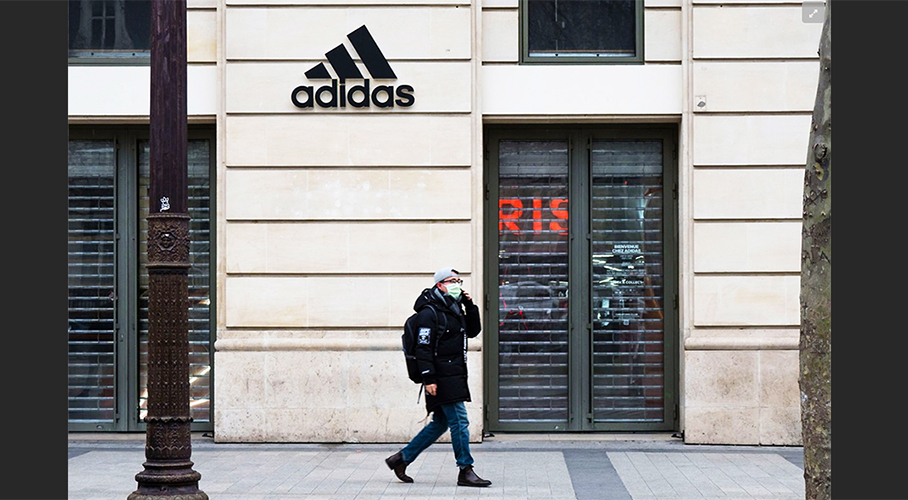By Thomas J. Ryan
<span style="color: #a1a1a1;">Adidas, on Monday, reported a 19 percent drop in sales for the first quarter, as more than 70 percent of its stores worldwide remain closed as a result of Covid-19. For the second quarter, officials forecast a loss as currency-neutral sales are expected to sink more than 40 percent.
Adidas’ officials on a conference call with analysts estimated that 60 percent of the company’s business is at a “standstill” with only e-commerce and stores in a few countries open.
“Our results for the first quarter speak to the serious challenges that the global outbreak of the coronavirus poses even for healthy companies,” said Adidas CEO Kasper Rorsted. “At the moment, we are focused on managing the current challenges and doubling down on the recovery in China and the opportunities we see in e-com. While we prepare for the return to a more normalized state of the business, we also remain realistic. Over 70 percent of our stores worldwide are currently closed.”
…
In the quarter ended March 31, net sales slumped 19.2 percent to €4.75 billion ($5.14 bn). Currency-neutral revenues decreased 19 percent.
Adidas Brand’s sales were down 20.3 percent on a currency-neutral basis (20.1 percent reported) to €4.27 billion ($4.62 bn). Currency-neutral declines of 20 percent were seen in Sport Performance and 16 percent in Sport Inspired.
Reebok’s sales were off 11.9 percent on a currency-neutral basis (11.4 percent reported) to €372 million ($403 mm). Among categories, Sport declined 13 percent and Classics were down 10 percent.
Adidas said the global spread of the coronavirus led to a significant number of store closures — both own- and partner-operated — and a pronounced traffic reduction within the remaining store fleet with a corresponding negative impact on Adidas’ top-line performance.
Continued strong currency-neutral growth of 35 percent in e-commerce — the only channel that has remained fully operational in most parts of the world — could only partially offset the material revenue decline in the physical channels. E-commerce sales saw an acceleration to 55 percent growth in March.
…
<span style="color: #a1a1a1;">Revenue development by region reflects the patterns of the global coronavirus outbreak.
In the Asia-Pacific region, sales plunged 44.9 percent on a currency-neutral basis (44.7 percent reported) to €1.18 billion ($1.28 bn). Operating margin eroded to 22.3 percent, down 16.0 percentage points. Adidas noted that it has been experiencing “significant revenue declines” in Greater China since the end of January with Japan and South Korea showing steep declines since March.
The decline in Asia-Pacific was mainly driven by a sales decline of 58 percent on a currency-neutral basis to €800 million ($866 mm) in Greater China. The extent of the decline reflects product takebacks in a triple-digit-million euro amount to manage inventory levels in the market.
Adidas said, “While stores in Greater China and South Korea reopened during March, closures came into effect in most other parts of the world following the rapid global spread of the coronavirus. Up until this point, the company had recorded a currency-neutral revenue growth of 8 percent outside of Asia-Pacific for the first two months of the year.”
Among other regions, sales in Emerging Markets declined 11 percent in the quarter on both a currency-neutral and reported basis to €293 million ($317 mm). Operating margin reached 25.1 percent, down 5.6 percentage points.
Sales in Europe were down 8.1 percent currency-neutral (8.0 percent reported) to €1.43 billion ($1.55 bn). Operating margin reached 21.5 percent, down 4.7 percentage points.
Latin America dipped 0.4 percent on a currency-neutral basis to €339 billion ($367 mm) and slumped 9.7 percent on a reported basis. Operating margin was 11.6 percent, down 4.9 percentage points.
North America’s revenues were up 0.8 percent on a currency-neutral basis (3.8 percent reported) to €1.2 billion ($1.3 bn). Operating margin in North America was 7.1 percent, down 3.7 percentage points.
The strongest region was Russia, up 9.0 percent on a currency-neutral basis (12.8 percent reported) to €154 million ($167 mm). Operating margin totaled 22.1 percent, up 3.1 percentage points.
…
Net income from continuing operations in the quarter tumbled 97 percent to €20 million ($21.7 mm).
Gross margin fell 420 basis points to 49.3 percent. A less favorable regional mix due to the over-proportionate sales decline in Greater China, negative currency developments, as well as costs related to the cancellation of purchase orders in order to adjust the inbound flow of inventories to the current circumstances, drove the margin decline.
Other operating expenses dipped 0.5 percent to €2.31 billion ($2.5 bn) and, as a percentage of sales, increased 910 basis points to 48.5 percent.
Marketing and point-of-sale expenses remained stable at €704 million ($762 mm) against €703 million a year ago as the majority of its consumer marketing and product activation efforts took place during the first two months of the year and accelerated investments were made to support its e-commerce business. As a percent of sales, marketing and point-of-sale expenses were up 290 basis points to 14.8 percent.
Operating overhead expenses slipped 0.8 percent to €1.6 billion ($1.73 bn), including the impact of higher bad debt allowances in the quarter. As a percent of sales, operating overhead expenses expanded 630 basis points to 33.7 percent.
Operating profit plunged 92.6 percent to €65 million ($70 mm), representing an operating margin decline of 13.5 percentage points to 1.4 percent from 14.9 percent a year ago. The combined impact from the product takebacks in Greater China, the cancellation of purchase orders and the increase in bad debt allowances had a negative effect on the first-quarter operating profit in an amount of around €250 million ($271 mm).
Inventories at the quarter’s close climbed 31.9 percent to €4.33 billion ($4.7 bn) due to inevitably lower-than-expected product sell-through caused by the broad-based store closures. On a currency-neutral basis, inventories were up 36 percent.
Operating working capital increased 8 percent to €4.64 billion ($5.0 bn) and was up 12 percent on a currency-neutral basis. The increase in inventory was partly offset by an 8 percent decline in accounts receivable (down 5 percent currency-neutral) and a 23 percent increase in accounts payable (up 25 percent currency-neutral).
The company’s operating cash consumption during the quarter, which was mainly driven by the increase in operating working capital and limited by effective measures to maximize cash inflows while minimizing outflows, was offset by the utilization of existing credit lines, both committed and uncommitted. As a result, the company had a cash position of €1.98 billion ($2.1 bn) at March 31, 2020, around two-thirds of which is held at Adidas AG and hence is directly accessible.
…
On the call, Rorsted said the company’s short-term priority will be a focus on cash. Efforts to increase cash inflows include accelerating online growth, prioritizing China and other open markets, and intensifying credit collection efforts.
Steps to reduce cash outflows include being proactive in adjusting its order book to limit trade payables. Adidas is also reducing discretionary spend, cutting management compensation, optimizing short-time working, and canceling marketing activities. Capital expenditures have likewise been reduced, including postponing retail expansion and remodeling efforts as well as IT projects
Efforts to provide additional liquidity to help weather any COVID-19 fallout including drawing down on committed and uncommitted credit lines, repatriating cash from foreign entities and securing bridge financing through KfW syndicated loan. On April 14, Adidas announced that the company received the approval of the German government for the participation of KfW, Germany’s state-owned development bank, in a syndicated revolving loan facility amounting to €3.0 billion.
The inventory overflow also reflects moves to take back millions in products to manage inventories across the marketplace. To better balance inventories, Adidas has partially canceled Q2/Q3 orders. Orders postponed for Q2/Q3 are expected to fulfill Q4 supply needs.
Adidas plans to hold some “evergreen” styles for sale for the 2021 year. A larger part of the remaining excess inventory will be sold through Adidas’ factory outlets. To a significantly less degree, Adidas’ own e-commerce channels and its wholesale partners will be used to liquidate excess goods.
Adidas raised its target for e-commerce to more than €4 billion, up from €3 billion in 2019 and representing a gain of more than a third. E-commerce sales last year represented 13 percent of the total.
Rorsted noted that in most countries on lockdown, it took two to three weeks after store closures for online sales to begin to pick up. Steps to propel online growth include reallocating existing inventory from stores, shifting marketing investments to digital channels, accelerating app initiatives as well as partnerships such as on with HypeDrop, the online mystery box website.
Adidas said the recovery in China is only started to materialize in March. The e-commerce business in China also saw declines during February but recovered much quicker than in-store growth. Online sales have more than doubled year-over-year in the first weeks of April. In-store sales are still down in April year-over-year as traffic is only slowing normalizing. China’s conversion rate – the portion of store visitors who make a purchase – likewise is improving week by week but not yet back to what it was before the shutdowns, said Rorsted.
“When people have been in quarantine for six or eight weeks, it takes some time for people to return to normal,” said the CEO. He is optimistic, though, that China will return to previous double-digit growth rates in the second half of the year.
Rorsted said Adidas was trying to apply what it learned in China to other parts of the world where retailers are expected to open throughout May and June. One lesson is to keep consumers engaged online before stores reopen.
Rorsted stressed that Adidas well-positioned for long-term growth. Growth drivers include consumers across the globe developing an increased appreciation of well-being and physical exercising. He noted that record sales of yoga mats are occurring as people exercise at home. Rorsted also believes the Adidas Brand is best-placed to benefit from any potential market consolidation resulting from the pandemic. Finally, he said Adidas should benefit from its advanced online network as social distancing has been driving faster change in behavior toward digital tools and channels
…
<span style="color: #a1a1a1;">Looking at the current quarter, Adidas the despite sequential recovery in Greater China in the first three weeks of April, and global e-commerce revenues seeing accelerating growth, overall revenue development remains severely impacted by a significant number of store closures across Europe, North America, Latin America, Emerging Markets, Russia/CIS, and large parts of Asia Pacific.
Adidas said that at this point in time, more than 70 percent of the company’s store fleet is still closed. The company is making use of the flexibility in its operating cost base but largely refraining from measures that would jeopardize future prospects. Consequently, both top- and bottom-line declines in the second quarter of 2020 “are currently expected to be more pronounced than those recorded in the first quarter, with currency-neutral sales projected to come in more than 40 percent below the prior-year level and the operating result to be negative.”
Adidas said that given prevailing uncertainties, primarily around the duration of store closures and the pace of normalization subsequent to stores reopening, it is still unable to provide an outlook for the full year 2020.
Rorsted stated, “Despite the current situation, I am confident about the attractive long-term prospects this industry provides for Adidas. Consumers are developing an increased appreciation of well-being. They want to stay fit and healthy through sports. Our focus on accelerating our own-retail and digital business will serve us even better in the future. We are well-positioned as a global company with strong brands.”
Photo courtesy Adidas/Getty
















